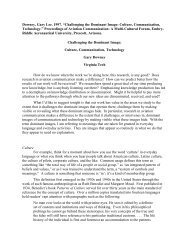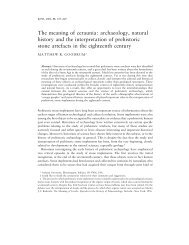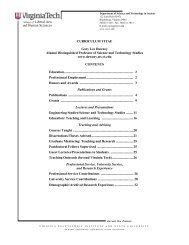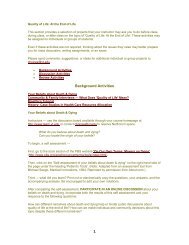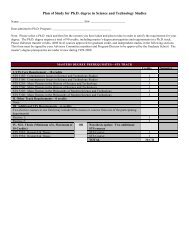David Boyd Haycock, William Stukeley: Science, Religion and ...
David Boyd Haycock, William Stukeley: Science, Religion and ...
David Boyd Haycock, William Stukeley: Science, Religion and ...
Create successful ePaper yourself
Turn your PDF publications into a flip-book with our unique Google optimized e-Paper software.
556 BOOK REVIEWS—ISIS, 97 : 3 (2006)<br />
have emphasized how central notions of paternity<br />
<strong>and</strong> maternity <strong>and</strong> models of reproduction<br />
<strong>and</strong> inheritance are to both cosmologies <strong>and</strong> social<br />
practices. Birthing the Nation is best seen in<br />
this context.<br />
LisaForman Cody considers along eighteenth<br />
century, from the second half of the seventeenth<br />
century <strong>and</strong> discussions within the Royal Society<br />
to the 1830s <strong>and</strong> the New Poor Law. One of her<br />
main arguments is that “sex <strong>and</strong> birth...helped<br />
the British to demarcate individual <strong>and</strong> corporate<br />
identities, including those of gender <strong>and</strong> the family”<br />
(p. 302). She suggests that major shifts in<br />
authority occurred during the period she treats:<br />
“male experts ...replaced female midwives,<br />
who had enjoyed a nearly exclusive control over<br />
the world of birth <strong>and</strong> knowledge about sexuality<br />
<strong>and</strong> reproduction for centuries” (p. 3). Cody insists<br />
on the revolutionary nature of this change,<br />
considering a number of contexts <strong>and</strong> case studies<br />
in order to illustrate her wider claims. In the<br />
process she draws on a wide range of sources,<br />
such as prints, plays, poems, diaries <strong>and</strong> letters,<br />
pamphlets, magazines, <strong>and</strong> institutional records.<br />
Some of the figures <strong>and</strong> examples she uses are<br />
familiar to historians, such as Mary Toft, who<br />
allegedly gave birth to rabbits in 1726, <strong>and</strong> the<br />
successful career of the Scot <strong>William</strong> Hunter.<br />
Cody places considerable explanatory weight on<br />
Hunter’s sympathetic relationships with his clients.<br />
“Evidence does exist, particularly in the<br />
case of <strong>William</strong> Hunter, that men-midwives facilitated<br />
emotional discussion with husb<strong>and</strong>s <strong>and</strong><br />
fathers, <strong>and</strong> played powerful roles in men’s<br />
lives” (p. 304). She mentions Hunter’s cultural<br />
interests in passing, <strong>and</strong> I wonder both whether<br />
his connoisseurship <strong>and</strong> collecting might have<br />
facilitated these relationships <strong>and</strong> how typical he<br />
was.<br />
It is well known that man-midwifery, one of<br />
the most important subjects treated in the book,<br />
elicited exceptionally ferocious emotional reactions.<br />
Historians should always be alert to such<br />
seemingly disproportionate reactions. It is not<br />
surprising that there is a lot of satirical material<br />
available. Many of the prints Cody uses fall into<br />
this category. The interpretation of such sources<br />
is exceptionally challenging, <strong>and</strong> it can be unclear<br />
what is properly to be inferred from them.<br />
Since some are by well-known figures, such as<br />
Thomas Rowl<strong>and</strong>son <strong>and</strong> James Gillray, it might<br />
have been worth paying close attention to makers<br />
as well as to their subject matter. Yet even<br />
the content of prints can be difficult to analyze,<br />
<strong>and</strong> some puzzling claims are made about them.<br />
For example, in discussing The Village Doctor<br />
(Rowl<strong>and</strong>son, 1774), Cody notes a “marked contrast”<br />
with another of his prints, “of a female<br />
midwife braving a late-night rainstorm . . . from<br />
1811” (p. 164). To me, this implies that the<br />
woman is more positively depicted than the man.<br />
Yet she is shown as obese, with thick lips <strong>and</strong> a<br />
bottle, in a manner that has been seen by others<br />
as distinctly hostile.<br />
We know that print makers <strong>and</strong> sellers draw<br />
on contemporary goings-on quite opportunistically—as,<br />
of course, do many writers. And are<br />
we to read the cases in <strong>William</strong> Smellie’s Treatise,<br />
first published in 1752, or supposed letters<br />
in the Sentimental Magazine (pp. 305–306)<br />
“straight”? These are difficult areas; my sense is<br />
that it is best to treat writings on such hotly contested<br />
matters as, more or less, strategic fictions.<br />
They are still valuable evidence, of course, but<br />
they testify more to affect than to practices. Certainly<br />
we can agree that feelings about “sex <strong>and</strong><br />
birth” ran extremely high in this period <strong>and</strong> that<br />
they had powerful, diverse political resonances.<br />
I think it is also clear that major changes took<br />
place in Britain over this period with regard to<br />
reproduction <strong>and</strong> that men-midwives provided<br />
wonderfully rich material for contemporary satire<br />
<strong>and</strong> commentary. We might usefully ponder<br />
further on the extent to which these shifts are<br />
properly deemed “revolutionary,” given that<br />
they took place over a long period of time, on<br />
the capacity of reproductive matters to be potent<br />
political mediators in many societies, on the role<br />
of artists <strong>and</strong> writers in responding to trends<br />
within science <strong>and</strong> medicine, <strong>and</strong> on how their<br />
products are best interpreted.<br />
LUDMILLA JORDANOVA<br />
<strong>David</strong> <strong>Boyd</strong> <strong>Haycock</strong>. <strong>William</strong> <strong>Stukeley</strong>: <strong>Science</strong>,<br />
<strong>Religion</strong>, <strong>and</strong> Archaeology in Eighteenth-<br />
Century Engl<strong>and</strong>. xiii 290 pp., plates, bibl.,<br />
index. Rochester, N.Y.: <strong>Boyd</strong>ell Press, 2002.<br />
$95 (cloth).<br />
The history of antiquarianism <strong>and</strong> archaeology<br />
in the seventeenth <strong>and</strong> eighteenth centuries has<br />
begun to attract the attention of historians in recent<br />
years. While this has improved our underst<strong>and</strong>ing<br />
of these disciplines <strong>and</strong> highlighted the<br />
important relationship that existed between natural<br />
philosophy <strong>and</strong> early archaeology, there is<br />
still much that remains to be explored about the<br />
activities of antiquaries, how archaeology <strong>and</strong><br />
natural history shaped each other, <strong>and</strong> how antiquarian<br />
researches were connected with wider<br />
social <strong>and</strong> intellectual problems. <strong>David</strong> <strong>Haycock</strong>’s<br />
examination of <strong>William</strong> <strong>Stukeley</strong>’s archaeological<br />
<strong>and</strong> scientific career represents a<br />
significant advance in our underst<strong>and</strong>ing of the
BOOK REVIEWS—ISIS, 97 : 3 (2006) 557<br />
complex relationships that archaeology in the<br />
eighteenth century had with a diverse array of<br />
scientific, religious, philosophical, <strong>and</strong> political<br />
issues.<br />
<strong>Haycock</strong> believes that in order to underst<strong>and</strong><br />
<strong>Stukeley</strong>’s works on Stonehenge <strong>and</strong> Avebury it<br />
is necessary to recognize the connection between<br />
his archaeological investigations <strong>and</strong> his career<br />
in natural philosophy. For this reason, <strong>Haycock</strong>’s<br />
book is divided into two sections. The<br />
first describes <strong>Stukeley</strong>’s education, his career as<br />
a physician <strong>and</strong> natural philosopher, <strong>and</strong> his<br />
close links to Isaac Newton. <strong>Haycock</strong> argues that<br />
<strong>Stukeley</strong> inherited a set of ideas <strong>and</strong> problems<br />
from Newton, some of which dealt with natural<br />
philosophy; but he draws on recent scholarship<br />
about Newton to show that <strong>Stukeley</strong> was also<br />
influenced by Newton’s extensive studies of<br />
chronology <strong>and</strong> ancient history, as well as his<br />
speculations about theology.<br />
Having demonstrated the Newtonian nature of<br />
<strong>Stukeley</strong>’s various scientific pursuits in the first<br />
section of the book, <strong>Haycock</strong> proceeds to examine<br />
<strong>Stukeley</strong>’s archaeological studies of Britain’s<br />
earliest antiquities, notably the stone circles<br />
at Stonehenge <strong>and</strong> Avebury. Whereas some recent<br />
historians of archaeology have focused on<br />
those aspects of <strong>Stukeley</strong>’s investigations that<br />
appear recognizable as “archaeology” while ignoring<br />
other aspects of his work—which was<br />
full of strange ideas about Druids <strong>and</strong> primitive<br />
Christianity <strong>and</strong> fanciful notions of the early history<br />
of Britain—<strong>Haycock</strong> situates <strong>Stukeley</strong>’s<br />
ideas about Stonehenge <strong>and</strong> Avebury within the<br />
intellectual context of eighteenth-century Engl<strong>and</strong>.<br />
What emerges is a remarkable picture of<br />
the complexity <strong>and</strong> sophistication of eighteenthcentury<br />
antiquarianism.<br />
<strong>Haycock</strong> shows how <strong>Stukeley</strong>’s interpretations<br />
of Stonehenge <strong>and</strong> Avebury were intimately<br />
linked to a host of problems being debated<br />
in the eighteenth century. <strong>Stukeley</strong> drew<br />
on the best historians <strong>and</strong> scholars of his day to<br />
link the ancient Britons described by Roman<br />
writers to the descendants of Noah who repopulated<br />
the world after the biblical deluge. Likewise,<br />
he drew on scholars writing on natural religion,<br />
primitive Christianity, <strong>and</strong> the idea of the<br />
prisca theologia to link the religion of the Druids<br />
to an ancient wisdom inherited from Adam that<br />
had been preserved among the Druids <strong>and</strong> was<br />
reflected in their ancient stone circles. Moreover,<br />
<strong>Haycock</strong> finds in <strong>Stukeley</strong>’s antiquarian researches<br />
material that links all of these issues<br />
with contemporary theological debates about the<br />
validity of the concept of the Trinity. Again,<br />
<strong>Haycock</strong> traces <strong>Stukeley</strong>’s interest in this problem<br />
in part to the Arianism of Newton <strong>and</strong> other<br />
prominent Newtonians <strong>and</strong> the scholarly defenses<br />
of Trinitarianism that were spurred in the<br />
eighteenth century by this threat to orthodox<br />
doctrine. <strong>Stukeley</strong> drew on new scientific methods<br />
<strong>and</strong> the emphasis on the importance of careful<br />
observation prevalent in the Royal Society,<br />
of which he was a member, in his surveys of<br />
ancient stone circles. And <strong>Stukeley</strong>’s interest in<br />
British antiquities, as a member of the Society<br />
of Antiquaries, fit well in an era of increasing<br />
British nationalism. Thus, what emerges from<br />
<strong>Haycock</strong>’s account of <strong>Stukeley</strong>’s antiquarian researches<br />
are the ways that they grew out of contemporary<br />
cultural, intellectual, <strong>and</strong> political<br />
concerns.<br />
<strong>Haycock</strong> draws on an impressive array of primary<br />
sources, many of them unpublished manuscripts.<br />
However, he does not always utilize<br />
relevant works of recent historians as successfully.<br />
While the first section of the book offers a<br />
valuable account of <strong>Stukeley</strong>’s life <strong>and</strong> career in<br />
natural philosophy <strong>and</strong> is important in establishing<br />
its significance to <strong>Stukeley</strong>’s antiquarian researches,<br />
the two halves of the book are not<br />
seamlessly integrated. However, the analysis of<br />
the second section of the book far surpasses<br />
much that has been written in the history of early<br />
archaeology.<br />
MATTHEW R. GOODRUM<br />
Claire Preston. Thomas Browne <strong>and</strong> the Writing<br />
of Early Modern <strong>Science</strong>. xiv 250 pp.,<br />
illus., bibl., index. Cambridge/New York: Cambridge<br />
University Press, 2005. $75 (cloth).<br />
Sir Thomas Browne st<strong>and</strong>s tantalizingly on the<br />
cusp between science <strong>and</strong> literature—intriguing<br />
for his engagement with natural philosophy<br />
through such works as Pseudodoxia Epidemica,<br />
but perhaps better known for his metaphysical<br />
speculations <strong>and</strong> sonorous prose. In the seventeenth<br />
century, Browne’s high repute derived<br />
largely from his learning, <strong>and</strong> he subsequently<br />
delighted Romantics like Samuel Taylor Coleridge.<br />
He has since become an established part<br />
of the literary canon. The twentieth century saw<br />
various monographs on him, notably those by<br />
F. L. Huntley <strong>and</strong> Joan Bennett, both published<br />
in 1962, while a volume of tercentenary essays<br />
edited by C. A. Patrides appeared in 1982. Most<br />
important of all, 1981 saw the publication of<br />
Robin Robbins’s monumental edition of the<br />
Pseudodoxia Epidemica, which devotes its entire<br />
second volume to the painstaking analysis of<br />
Browne’s sources.<br />
Claire Preston comes from a background in



